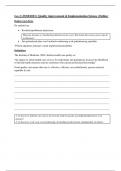Examen
Introduction to Psychology v. 2.1 Charles Stangor (Test Bank)
Cours
Introduction to Psychology, v. 2.1 Charles Stangor
Établissement
Introduction To Psychology, V. 2.1 Charles Stangor
Introduction to Psychology, v. 2.1 Charles Stangor (Test Bank)
Introduction to Psychology, v. 2.1 Charles Stangor (Test Bank)
[Montrer plus]
Publié le
17 juillet 2023
Nombre de pages
444
Écrit en
2022/2023
Type
Examen
Contient
Questions et réponses
Établissement
Introduction to Psychology, v. 2.1 Charles Stangor
Cours
Introduction to Psychology, v. 2.1 Charles Stangor
S'abonner
€15,03
Egalement disponible en groupe à partir de €42,19
Garantie de satisfaction à 100%
Disponible immédiatement après paiement
En ligne et en PDF
Tu n'es attaché à rien
Document également disponible en groupe (1)
Introduction to Psychology, v. 2.1 Charles Stangor (Instructor Manual with Test Bank)
€ 30,05
€ 42,19
2 éléments
©2013 Flat World Knowledge, Inc. 2 Chapter 1 Introducing Psychology SECTION 1 MULTIPLE-CHOICE QUESTIONS: 1. Your textbook defines psychology as which of the following? a. The science of behavior b. The study of mental processes c. The study of mental disorders and their treatment d. The science of mind and behavior Answer: d; Moderate 2. Allanah has declared psychology as her major. Which of the following alternatives best identifies what Alla nah will study? a. Mental processes b. Mind and behavior c. Psychological disorders and their treatment d. The development of the individual Answer: b; Moderate 3. Barry states that psychology is the study of the mind. Candace stat es that psychology is the science of behavior. How might you evaluate these two statements? a. Barry’s definition is correct. Candace’s definition is incorrect. b. Barry’s definition is incorrect. Candace’s definition is correct. c. Barry’s definitio n is too broad. Candace’s definition is correct. d. Both statements are partially correct. Answer: d; Moderate 4. What, if anything, unites psychology? a. All psychologists are committed to the scientific method. b. All psychologist s conduct research. c. All psychologists focus on measuring behavior. d. All psychologists use the same theoretical approach in studying mind and behavior. Answer: a; Moderate 5. Creating knowledge is to using knowledge as _____ is to _____. a. psychologist-practitioner; research psychologist b. psychologist-practitioner; experimental psychologist c. research psychologist; psychologist -practitioner d. research psychologist; experimental psychologist Answer: c; Moderate 6. Dr. Estevez is a cognitive psychologist. Dr. Francis is a school psychologist. Dr. Gigliotti is a counseling psychologist. Which of these individuals is most likely a research psychologist? (Introduction to Psychology, v. 2.1 Charles Stangor)



